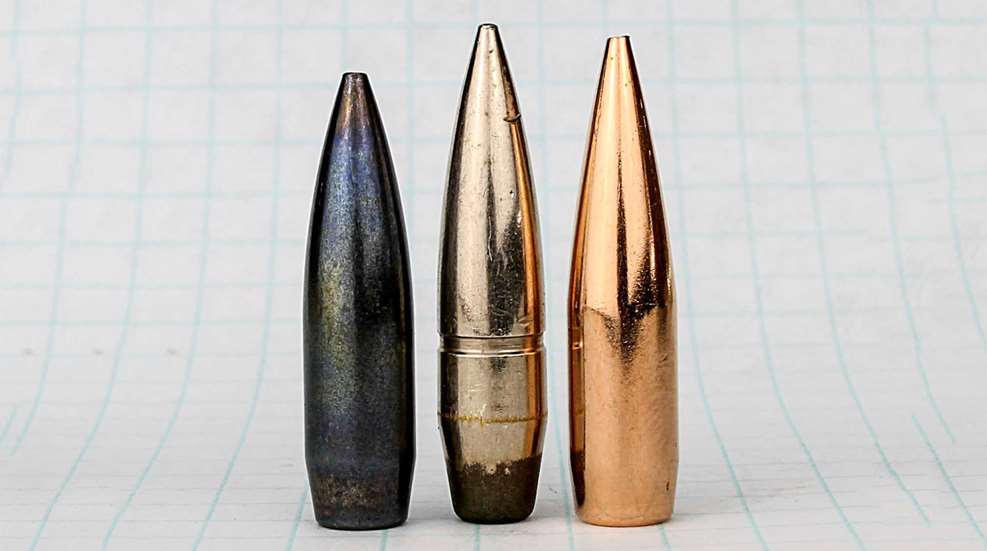
Above: A moly-coated .30 caliber Sierra 175-grain MatchKing (l.) and Berger 175-grain VLD (r.) flank a pulled GP11 bullet. The GP11’s .307-inch diameter starts behind the cannelure. Note the lengthy boat tail.
The 7.5x55mm Swiss cartridge has got two things going for it in Vintage Military Rifle competition: the bullet and the K31 rifle. The K31’s reputation for exceptional accuracy is due to its quality workmanship, tight bore and outstanding service ammunition. Best of all, replicating the ammunition is straightforward.
First FMJ
The 7.5x55mm Swiss cartridge has a history more significant than other Vintage Military Rifle (VMR) competition cartridges. In the early 1880s, Swiss Army Maj. (later Col.) Eduard Alexander Rubin introduced the concept of the full-metal-jacket (FMJ) bullet when he submitted his 7.5mm cartridge design to the Swiss government (though his first version was jacketed only at the front of the bullet). At that time, smokeless powders were still on the horizon, and yet Rubin, a mechanical engineer, clearly saw the advantages of a small-caliber, high velocity bullet over traditional larger caliber, relatively slow lead projectiles. Rubin loaded his first 7.5mm jacketed bullet cartridge with compressed black powder or semi-smokeless powder while awaiting the arrival of smokeless powder a few years later.
Concurrently, Col. Rudolf Schmidt designed a straight-pull bolt action rifle to accommodate Rubin’s cartridge, and the Swiss government subsequently adopted the first Schmidt-Rubin rifle in 1889. The rifle evolved through several permutations, beginning with the 12-shot Model 1889 sporting locking lugs in the middle of the bolt, then morphing through several improvements and culminating in the Model 31/55 or ZfK55 sniper rifle. As an infantry rifle, the Model 1931 Short Rifle, or K31, which we still see in VMR competition today, remained on active duty until 1958 and served in the reserves well into the 1970s. The 7.5x55mm Swiss cartridge soldiers on in Swiss fortress and armored-vehicle machine guns.
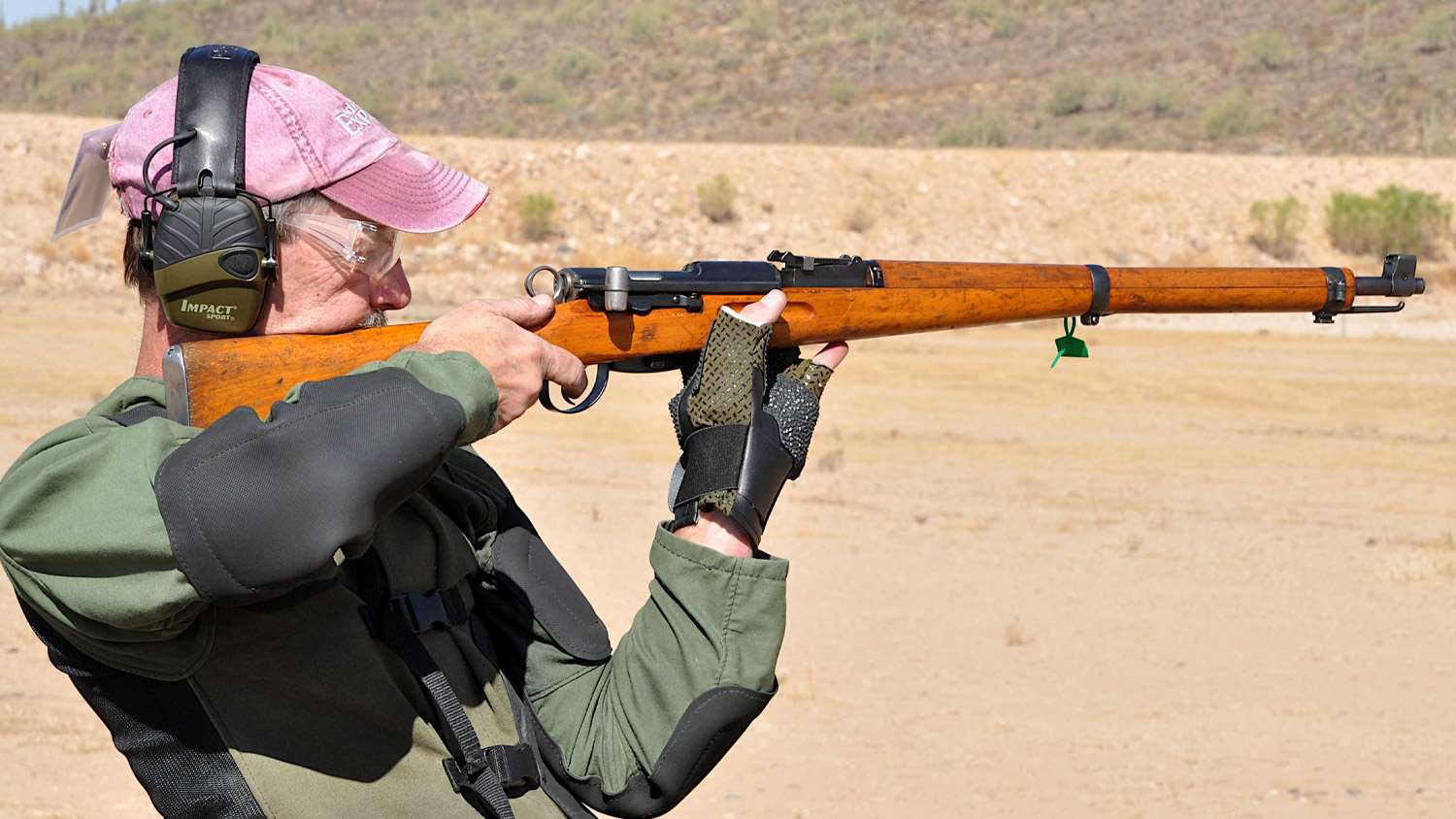
First .30 caliber
Many shooters believe the U.S. adopted the first .30 caliber military cartridge with the .30-40 Krag of 1892, but they are mistaken. Rubin’s 7.5mm bullet, designed a decade earlier and put into service three years before the Krag, is a true .30 caliber that handloaders today reload with standard U.S. .308-inch bullets. The “7.5mm” comes from the K31’s diameter of the bore across the lands, which is ostensibly 7.51mm/.2956 inch, not to the bottom of the grooves. Adding to the confusion, some older references to the cartridge include 7.45mm, 7.54 Swiss and 7.51 Swiss. It’s also sometimes called the 7.5 Schmidt-Rubin.

Researching groove diameter turned up not-entirely consistent information; however, it appears the Swiss intended for the groove diameters to be 7.78mm +/- .005mm or .3062 +/- .0001 inch. A perusal of online forums shows K31 shooters generally reporting groove diameters of .306 to .307 inch.
.308 works
Load data manuals and other references to the 7.5x55 Swiss cartridge list bullet diameter as .308 inch. Those authorities notwithstanding, the bullets I’ve pulled from Swiss GP11 service ammunition for the K31 do not measure .308 inch, they measure .306 to .307 inch behind the cannelure. In front of the cannelure, bullet diameter is .301 inch, so what we’re seeing here is essentially a bullet of “bore-riding” design, wherein the front of the bullet is the same diameter as the rifling lands (actually, about .005 inch larger with the GP11), and the rear of the bullet just bottoming out in the grooves.
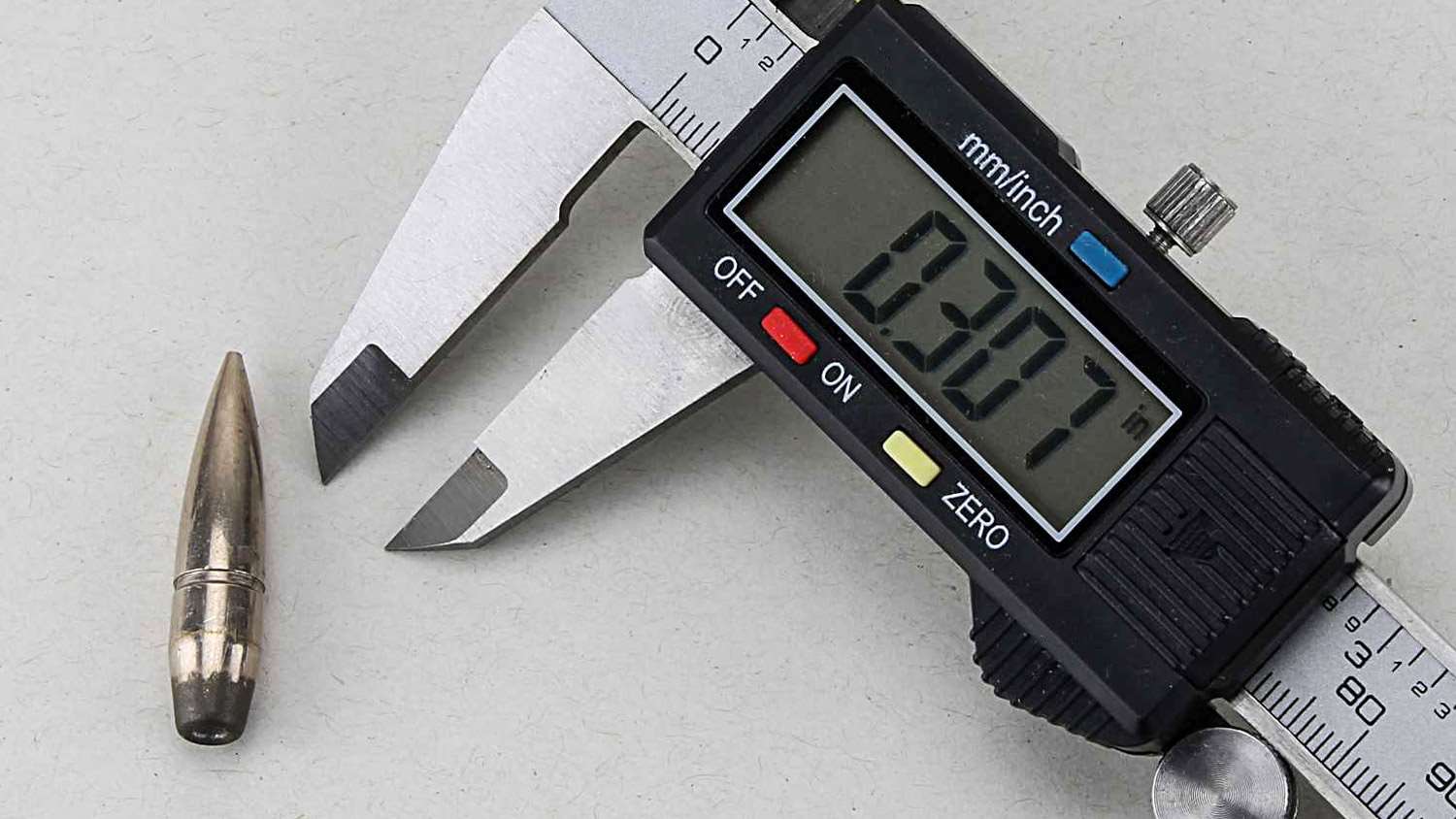
While the GP11’s bullet configuration has much to do with the K31’s reputation for precision (see below), handloaders have long known the Swiss rifle shoots very well with carefully assembled cartridges topped with quality .308-inch diameter jacketed bullets.
Twist rate of the K31 is 1:270mm—that is, one twist in 10.63 inches; bullet weight of the GP11 service cartridge is 174 grains. Let’s compare that to a couple of K31 battlefield contemporaries, the American Springfield M1903/M1903A3, British SMLE No.1 and No.4 Enfield rifles. The Springfield has a 1:10-inch twist to stabilize bullets of 150 to 173 grains; the Enfields stabilize a 174-grain bullet with the same twist rate. Though the K31 has a slightly slower twist at 1:10.63, it is obviously adequate for bullets of those same weights.
We have so many excellent choices in .30 caliber bullets in the 150- to 175-grain weight class available to us that it would be a time-consuming task to list them all here. However, given the quality of the K31 and its reputation for precision, this is one of those times when pairing a premium match-grade bullet to an unaccurized battle rifle sporting an original barrel may result in truly respectable target-grade, 200-yard groups. Berger Bullets’ 175-grain .308 VLD Target offering, or Sierra’s 175-grain MatchKing, for example, could prove to perform very well in your K31.
IMRs for .30s
The K31’s tight bore does warrant an extra nod to caution in sticking with published load data that keeps breech pressures within the K31’s limit of 45,500 psi. The combination of too-high pressure, a tight fit and an older rifle will lead to trouble.
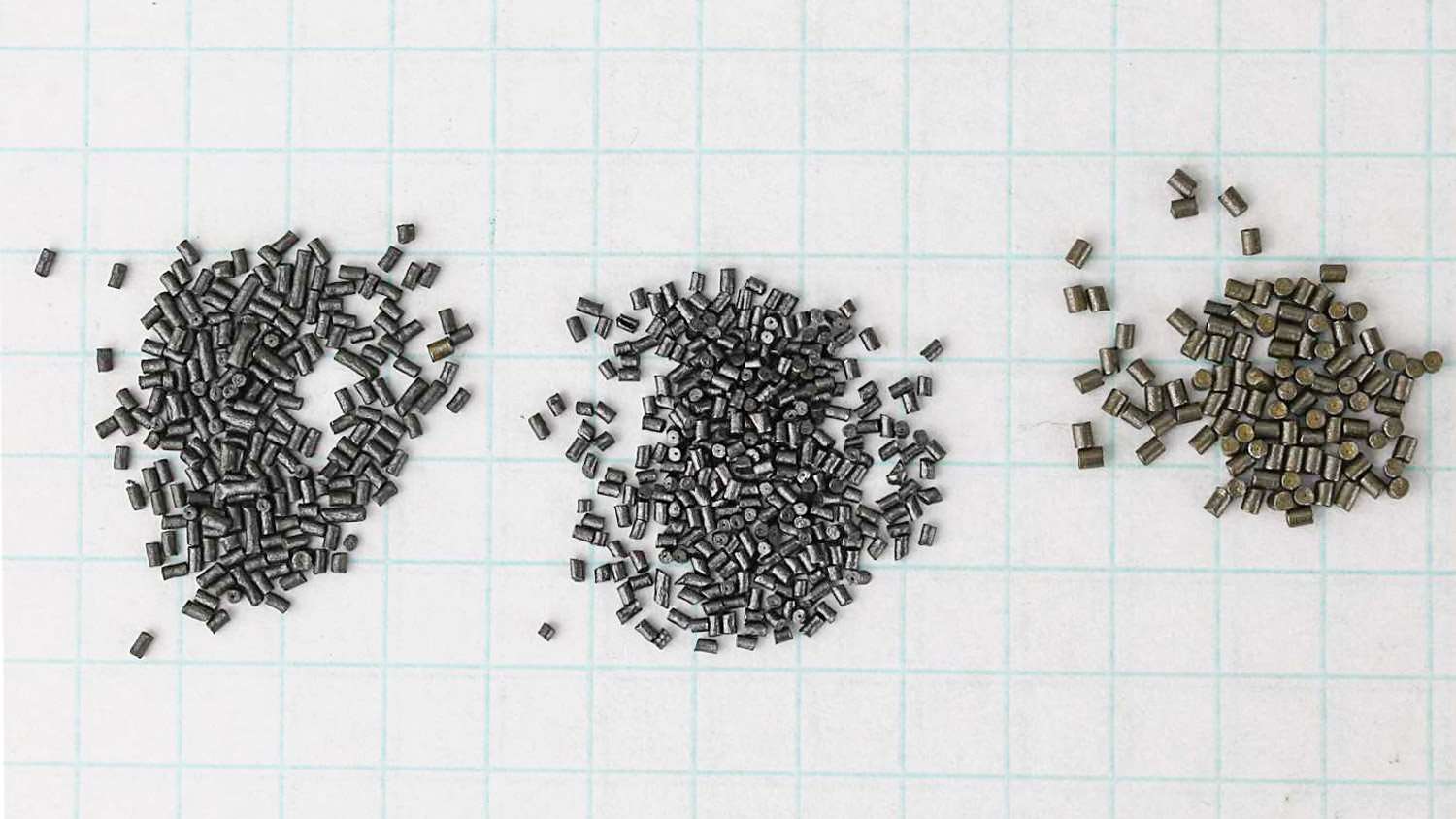
Among powders, you’ll find all the usual suspects for non-magnum .30 calibers listed in load data manuals for the 7.5x55 Swiss. Sierra favors the IMR powders almost exclusively, their best accuracy with 150- to 168-grain bullets provided by 45 grains of IMR 4064, and 45.8 grains of IMR 4350 doing the same for their 175-grain MatchKing. Lee lists no IMR powders at all, instead recommending VihtaVuori powders for 155- to 167-grain bullets and Hodgdon powders for 168 to 180 grainers. Velocities are quite respectable considering the need to keep pressures restrained, with the lighter bullets reaching 2,800 fps and the 175-grain bullets maxing out at 2,500 fps.
7.5 from .284 Win.
Dies for reloading the 7.5x55 Swiss are available from the usual sources at the usual expected price points of the various manufacturers without need for ordering custom dies. As with premium bullets, the K31’s inherent precision could take advantage of premium dies. Shell holders are Hornady, RCBS and Redding #2, Lee #3 and Lyman #6.
At this time, makers of 7.5x55 Boxer primer brass for reloading appears to be limited to Norma and Prvi Partizan. Graf & Sons has both in stock, the Norma going for $33 per 25 and the Prvi Partizan $30 per 50. An alternative that will also provide instant shooter gratification is to buy factory-loaded Boxer primed ammo and reload the brass after firing.
Another alternative is to convert .284 Win. cases by running them into a 7.5x55 Swiss full-length resizing die. If you go this route, don’t skimp on the resizing lube. Shooters were doing this before the influx of milsurp K31s prompted ammo makers to make new ammo for the rifles. The rim diameter of the .284 Win. case is slightly smaller (0.0252 inch) than that of the 7.5x55 Swiss, but the conversion usually works without any extraction problems.
Milsurp and factory ammo
Milsurp Swiss GP11 ammo for the K31 is still out there, some of it retailing for about 50 cents per round. Oddly, online auctioneers are garnering upwards of twice that, which is no bargain—especially considering its Berdan primer makes GP11 a one-shot deal here in the U.S. without special tools for dealing with the European primers.
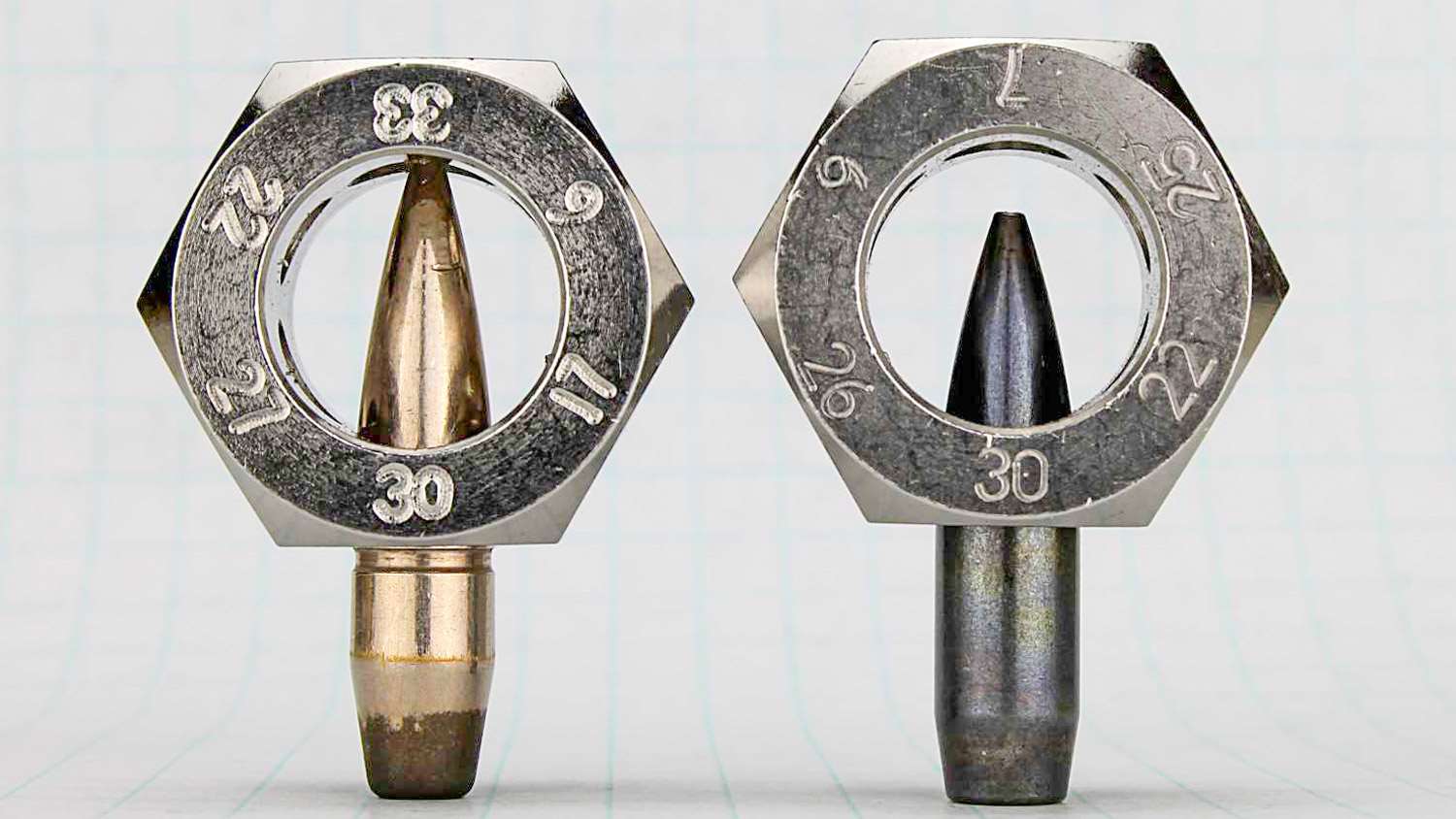
Advertising frequently touts GP11 as “match ammo” but, even though it has a reputation for superior precision and has routinely been used in competition, GP11 is not deliberate match-grade ammunition in the usual sense. The “11” in “GP11” refers to 1911, the year the Swiss updated the cartridge with non-corrosive primers. Since then, GewehrPatrone 1911 (“Rifle cartridge 1911”) has been the standard-issue ball ammunition for all so-chambered Swiss rifles and machine guns. It’s just exceptionally good standard-issue ammo.
A diligent online search for factory ammo turned up a Prvi Partizan offering with a 174-grain FMJ bullet for 75¢ per round, and Graf & Sons has a custom loading featuring Hornady’s 165-grain SST bullet at $1.49 per round. Sellier & Bellot has a 174-grain FMJ offering, but I did not find a U.S. retailer carrying it. Hornady has discontinued loading the cartridge, and it appears Wolf may have followed suit.
Shoot twice
Pairing the K31 rifle with its GP11 ammunition arguably resulted in the most-accurate combat rifle ever in general issue to a nation’s military forces, but among vintage military rifles, the K31 has probably seen the least employment in combat. It’s popularity in VMR competition may be hampered by its charger—or rather, the lack of it. And, one must concede, the rifle/cartridge pairing would be significantly improved for competition if the K31 rear sight were windage adjustable. While VMR competition rules don’t allow us to do anything about rear sight windage, Northridge offers reusable polymer chargers for the K31. These are excellent replacements for the original disposable Swiss chargers of varnished papier-mâché with tinned iron retaining tabs that eventually break off after continued re-use.
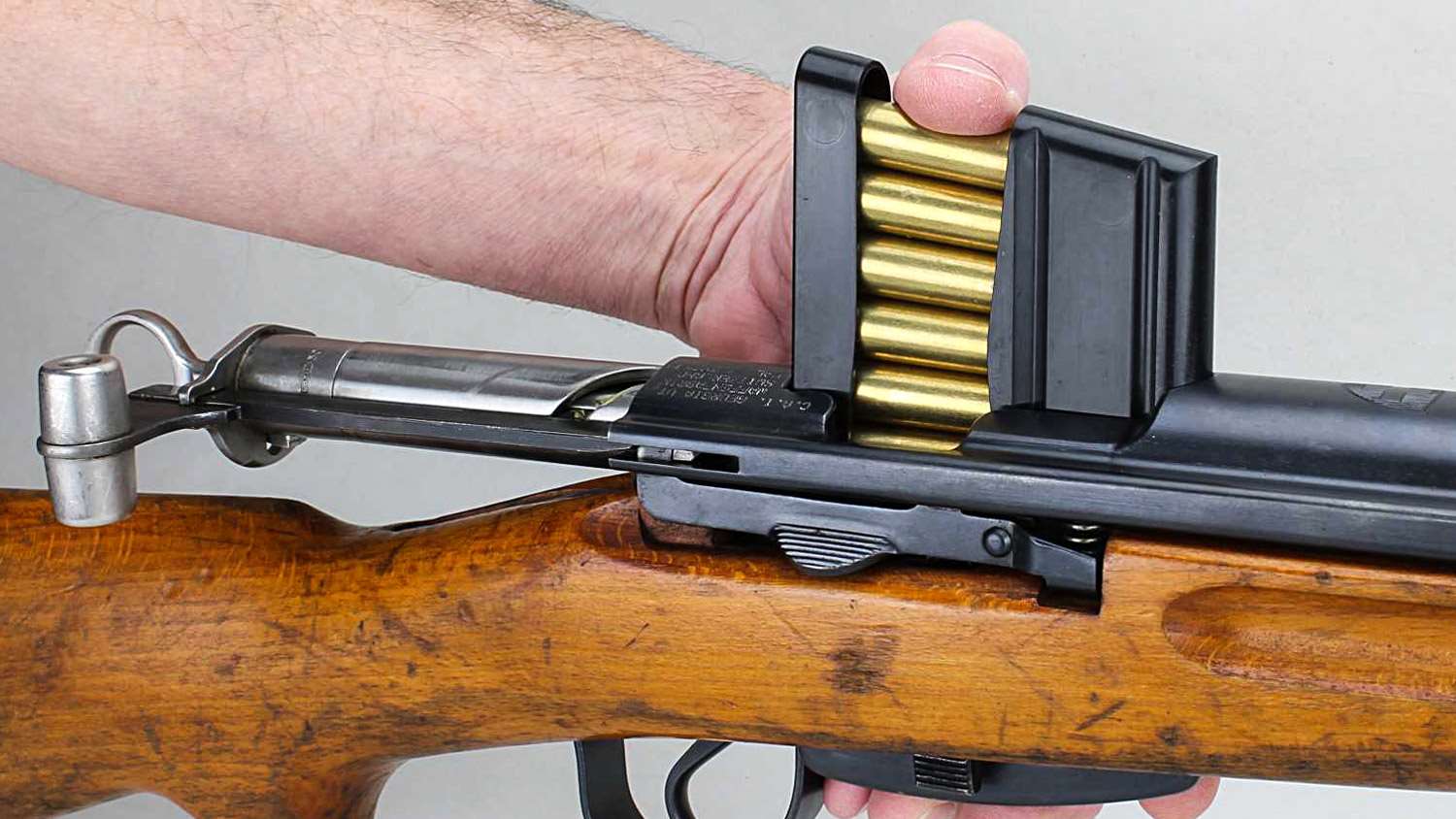
The 7.5 Swiss cartridge, still on active duty for well over a century, is historically significant and possessed of superior precision in the K31 rifle. In a famous anecdote, when the Kaiser Wilhlem visited Switzerland early in the 20th century, he supposedly taunted a Swiss sergeant, saying that in the event Germany and Switzerland were to clash in war, the German Army was twice as big as the Swiss Army. The sergeant is said to have replied, “Then we shall have to fire our rifles twice, Your Excellency.”
That’s about the best endorsement from its user a rifle and cartridge could receive.
Read more articles by Art Merrill:
- Vintage Rifle Cartridges You May Not Know
- New: Berger .22 Caliber 85.5-Grain Long-Range Hybrid Target Bullet
- What Is That Milsurp Loading?
- G1 vs. G7 Ballistic Coefficients
- Quarter Points And Ball In High Power
- Lapua’s Arizona Test Center For Smallbore Competitors
- New Vintage Sniper Optics: Using The M73G4 Sniper Scope For Competition
- Last Cartridge Of An Empire: .303 British
- America’s .30-40 Krag Is Still In The Ring For VMR Competition
- A Hiker’s Sidekick: Mom’s H&R Model 929
- Too Much Recoil? The Arisaka May Be Your Solution


































